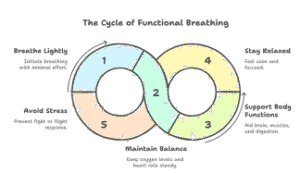Even though we all want to be confident, forcing yourself to be that way doesn’t really work. You may try to fake it till you make it but you very seldom make it happen on its own. In order to improve confidence in a real sense you need to begin with taking control of your emotions and calming down. That starts with your breathing.
You can’t be confident with fast, shallow breathing as that tells your body your are under stress. On the other hand, slow, steady breathing sends a signal to your brain that you are safe and capable. When you feel calm and capable your voice becomes steady, your mind becomes crystal clear and only then does natural confidence show through.
Let’s take a look at how you can learn how functional breathing can help improve your confidence from the inside out. You’ll also learn to use simple anchoring techniques to remain calm and channel past feelings of confidence to make this feeling available whenever you need it.
How Breathing Shapes Confidence
How you breathe can change how you feel and it does so quickly. When your breathing is slow and steady, your body exudes confidence. On the other hand, when your breathing is poor, you look and feel uncertain.
Here’s how breathing affects your confidence:
- Calms down the nervous system: Slow, nasal breathing signals your body’s “rest and focus” mode. This decreases stress hormones and helps you think more clearly.
- Decrease your heart rate: Calm steady breathing tells your brain you’re safe. As a result your body relaxes instead of preparing for stress.
- Improves focus: Functional breathing increases oxygen flow to the brain, which Improves mental focus and helps you stay aware.
- Strengthens posture: Breathing helps strengthen your core and straightens your spine, both of which are clear indicators of confidence in others.
- Balances emotions: A steady, even breath keeps you from reacting too soon when stress increases.
Each slow breath tells your body you’re in control Over time, this becomes your normal state of being. Instead of faking being confident, you’ll start to feel it naturally.

What Is Functional Breathing?
We usually don’t think about our breathing or how we breath even though we should. The way you breathe affects how your body and brain work. Functional breathing means breathing the way your body was designed to—light, slow, and through the nose.
Here’s what that looks like:
- Breathe through your nose, not your mouth. The nose warms, filters, and humidifies air, which protects your airways and improves oxygen use.
- Breathe low and quiet. The movement should come from your diaphragm, not your shoulders or chest.
- Keep your rhythm steady. Stop sighing or gasping—your breath should feel calm and controlled.
- Exhale longer than you inhale. This brings about your body’s calming response and steadies or even lowers your heart rate.
You’ll know your breathing needs fixing if you find yourself:
- Breathe through your mouth when at rest.
- Feel your chest move more than your lower ribs and stomach.
- Sigh, yawn, or take big breaths often.
- Get tired or tense during the day without a real reason.
Functional breathing balances your system. It’s pretty basic, but it changes everything—from how calm you feel to how confident you appear.
The Functional Breathing Routine to Improve Confidence
Use this short routine to calm your body and increase your focus in a matter of just a few minutes. Use it anytime you need to gain confidence—before a meeting, a negotiation, or meeting someone new.
Steady Confidence Breath (3–5 minutes)
- Sit or stand. Relax your shoulders
- Close your mouth and breathe through your nose quietly.
- Inhale for 4 seconds. Let your lower ribs expand outward and down as your diagram lowers.
- Exhale for 6 seconds. Allow your diaphragm to rise and lower to a rested position as the air leaves your lungs slowly through your nose.
- Pause a couple of seconds before inhaling again.
- Breathe lightly. Don’t force air into your lungs. Let your diaphragm do most of the work making your breath feel smooth and effortless.
- Keep calm. As your breathing becomes steady, notice your body relaxing and your mind become clear.
Try this for 3 to 5 minutes each day or before a difficult situation occurs.
With regular use or practice, this:
- Lowers your stress hormones.
- Helps your heart and brain remain calm.
- Builds calm, steady confidence you can activate on demand..
Confidence isn’t something people have naturally – its something you need to train to enable.

Why Functional Breathing Works
Functional breathing changes how your body reacts to pressure. It turns stress into a state of calmness and nervous energy into quiet confidence.
Here’s why it works:
- Activates the vagus nerve: Slow nasal breathing triggers the body’s calm response, lowering your heart rate and reducing stress [x].
- Balances oxygen and CO₂: Light breathing keeps more carbon dioxide in your blood, helping oxygen reach your brain and muscles more efficiently.
- Sharpens focus: A balanced breath clears mental grogginess so you think and speak with clarity.
- Improves body language: As your breathing deepens from the diaphragm, your posture straightens and your voice sounds stronger—both signs of confidence.
- Builds consistency: Each calm breath trains your body to stay relaxed even in stressful moments.
When your body feels calm, your mind does as well. Functional breathing gives you that calm footing so confidence feels more natural and not forced.

Anchoring Calmness – Making Confidence Stick
Once your breathing is calm, you can take it a step further. Anchoring helps you remember and relive a feeling so you can bring it back anytime. It’s a simple technique borrowed from NLP (Neuro-Linguistic Programming) that links a physical cue to an emotional state—like empowerment, or confidence.
How to Create Your Confidence Anchor
- Start with calm breathing. Do your functional breathing exercise for a few minutes until you feel calm and collected.
- Remember a moment. Think of a time when you felt strong, capable, or confident. Let that feeling grow inside you.
- Use a cue. As the feeling strengthens, press your thumb and finger together—or choose another small gesture that feels right. The cue becomes associated with that feeling.
- Repeat often. Practice this while breathing calmly every day.
- Use the cue when needed. Before a meeting or stressful situation, take one steady breath and use your anchor cue to bring back that feeling of confidence.
With practice, your brain connects that simple cued action with your calm breathing and the feeling of confidence. The more you practice, the faster you can shift into the state of calm, cool, and collected composure whenever you want.
Putting It into Daily Practice
Practicing the feeling of confidence doesn’t take hours a day – it takes consistency. When you repeat small habits like functional breathing and anchoring calmness, your body learns to remain steady under pressure.
Try this simple practice to make it part of your routine:
- Morning start: Begin your day with 3 minutes of functional breathing to set a calm tone.
- Before the world comes at you: Use your breathing and anchor cue before difficult situations like client calls, meetings, or presentations.
- Check your posture: Stand tall, relax your shoulders, and breathe lightly through your nose. This posture needed for better breathing also signals confidence.
- Evening reset: End your day with a few slow breaths to destress and clear your mind.
The more you practice, the easier it is to become calm and confident on command. You won’t need to “think” confident—you’ll just become it.
Conclusion – Confidence Is Trained Through Calm
Confidence isn’t something you think you need to fake or acquire. Actually its is something you train. When your breathing is steady, your mind becomes steady and calm, making you feel confident.
Functional breathing gives you control over your body because it gives you control over your emotions. Anchoring helps you channel the emotions you want to feel, recalling the feeling of confidence or any other emotion (with different anchoring cues) when it suits you. Together, they give you a steady base that keeps you composed, focused, and ready for anything.
You don’t need to force confidence. You just need to remember how it feels and to breathe it in.
Check out How to Stop Mental Distractions: Breathing for Better Focus.







